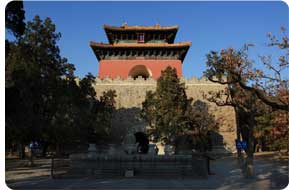 Ming Tombs lie in a broad valley to the south of Tianshou (Longevity of Heaven) Mountain in Changping County,about 50 kilometers northwest from Beijing City. The name itself exactly implies what it is inside. It consists of thirteen emperor mausoleums of the Ming Dynasty from 1368 to 1644. The whole mausoleums group totally covers an area of 40 square kilometers, which had took up to more than 200 years to complete. It was really a tremendous project in that time. Ming Tombs lie in a broad valley to the south of Tianshou (Longevity of Heaven) Mountain in Changping County,about 50 kilometers northwest from Beijing City. The name itself exactly implies what it is inside. It consists of thirteen emperor mausoleums of the Ming Dynasty from 1368 to 1644. The whole mausoleums group totally covers an area of 40 square kilometers, which had took up to more than 200 years to complete. It was really a tremendous project in that time.
Ming Tombs lie in a broad valley to the south of Tianshou (Longevity of Heaven) Mountain in Changping County about 50 kilometers northwest from Beijing City. The name itself exactly implies what it is inside. It consists of thirteen emperor mausoleums of the Ming Dynasty from 1368 to 1644. The whole mausoleums group totally covers an area of 40 square kilometers, which had took up to more than 200 years to complete. It was really a tremendous project in that time. Ming Tombs were surrounded by hills from three sides, with Mangshan and Huyu flanked in both sides and Beijing Campagna right lies in front of it. All of the thirteen Ming mausoleums are arranged in well harmonious positions; however each one still possesses its own systems. Because of its long history, integrated and delicate upholster, it appears a high cultural and historic value.
Of the 13 tombs, two are open for viewing, Changling and Dingling. The tombs were built with symbolism in mind. In front of the tombs are square courtyards representing earth, this is where the above ground buildings are and it was in these buildings where the memorial rituals were performed. Behind the courtyards are the circular tomb mounds representing heaven.
The Dingling Tomb is the burial site of the Wanli emperor, the 13th Ming emperor who ruled for 48 years until his death in 1620. Two of his empresses are also buried here along with him. The extremely well-built tomb took over 600,000 laborers six years to complete. Excavation of the tomb occurred from 1956 to 1958, the underground chamber was discovered through sheer luck when archeologists through a stone tablet left by the original builders. The stone tablet gave instructions on how to find the tomb – this was necessary when the tomb was reopened for the burial of the emperor. |



